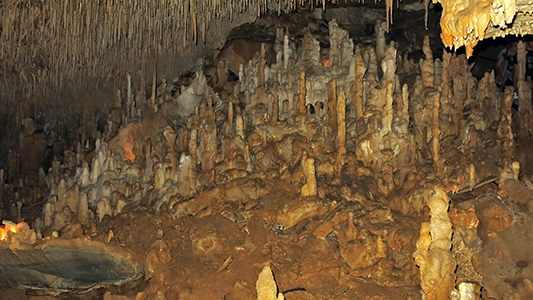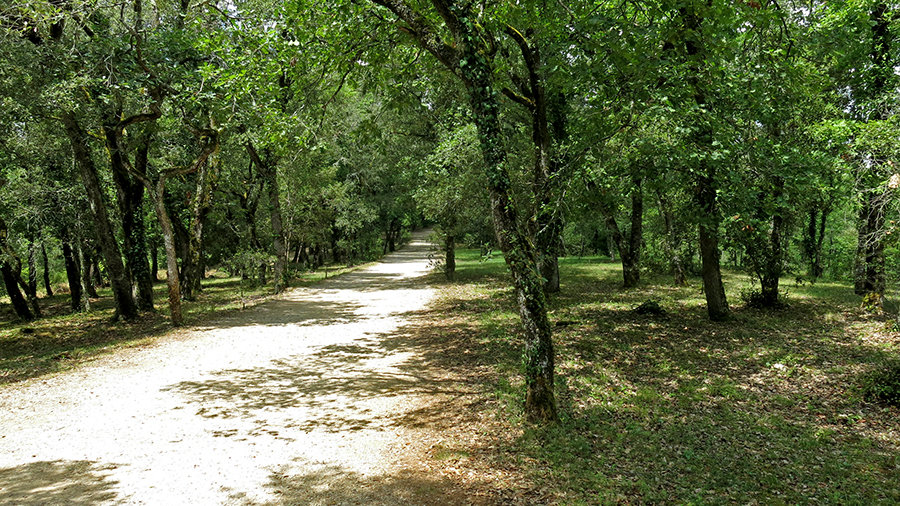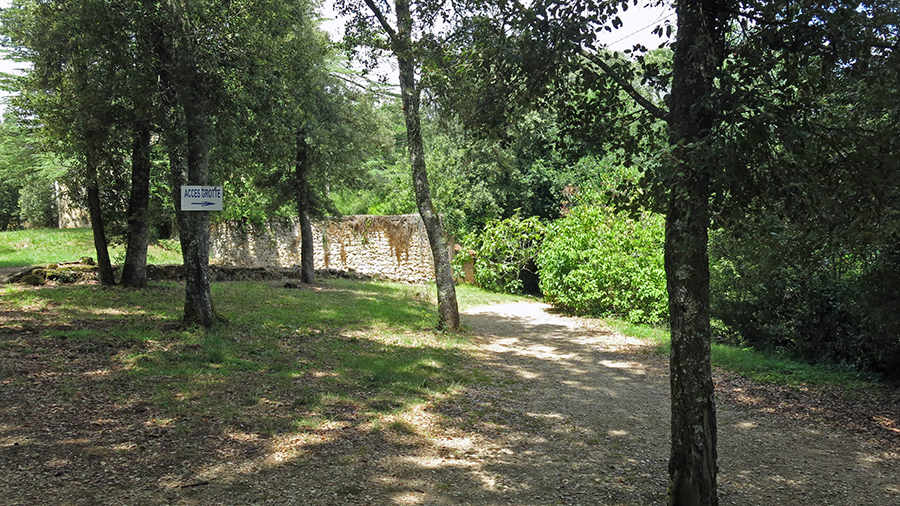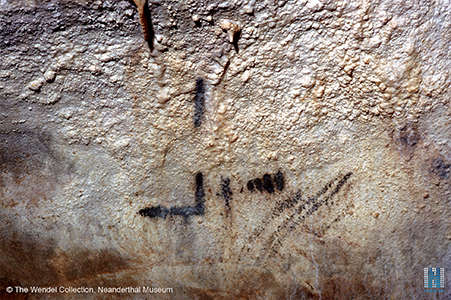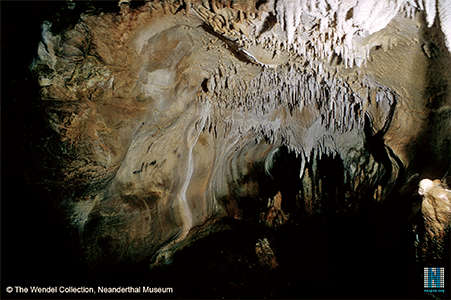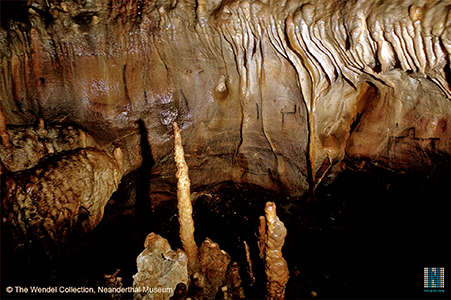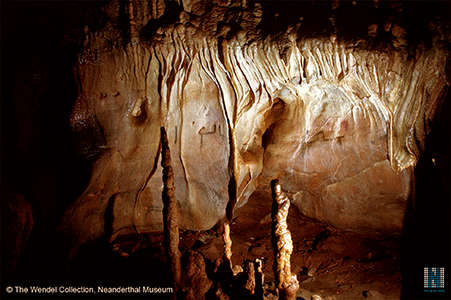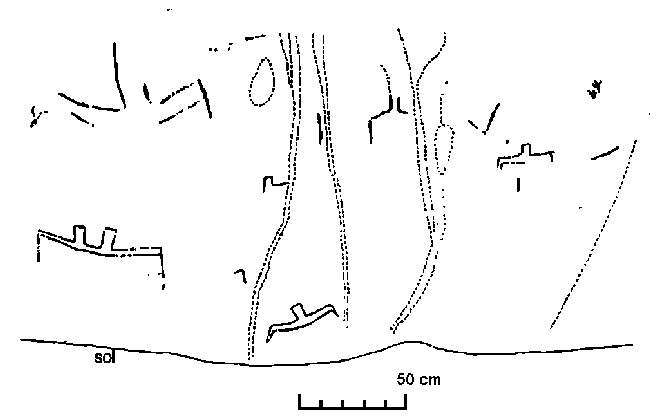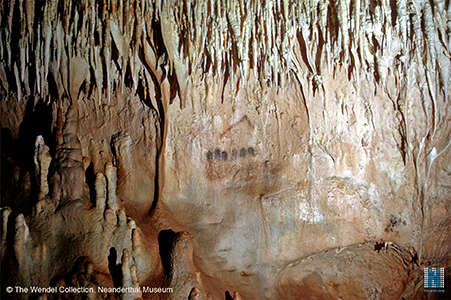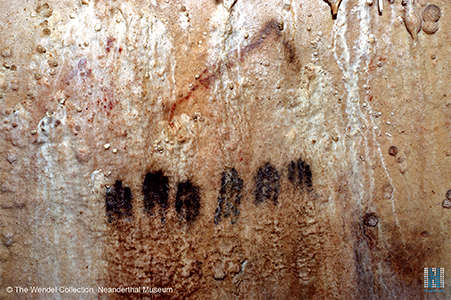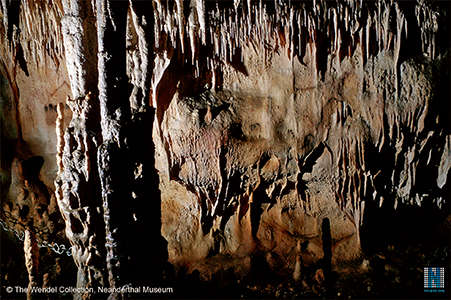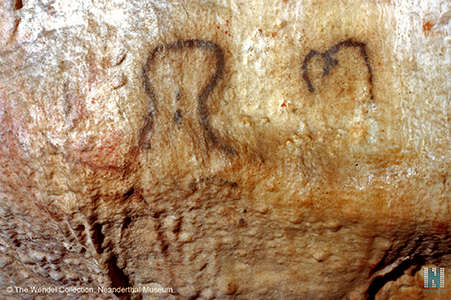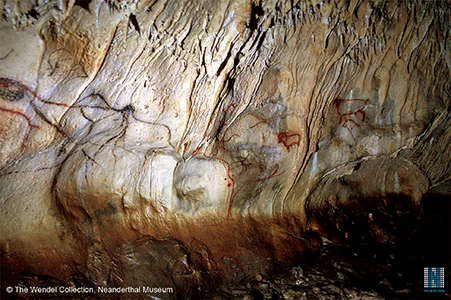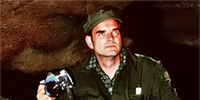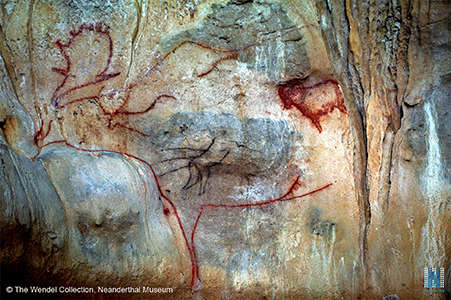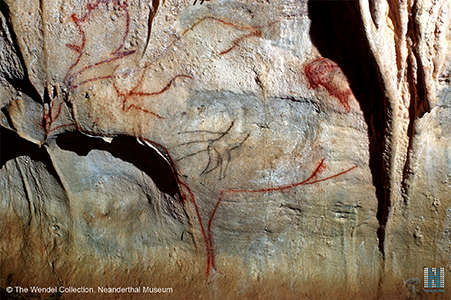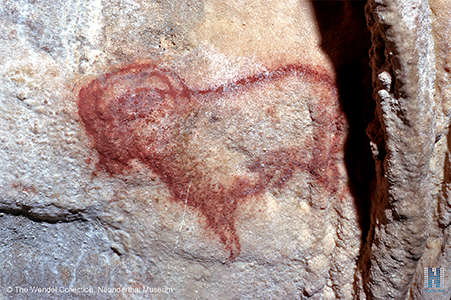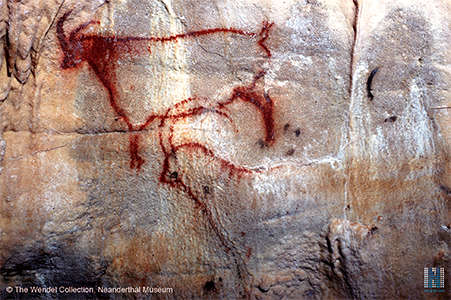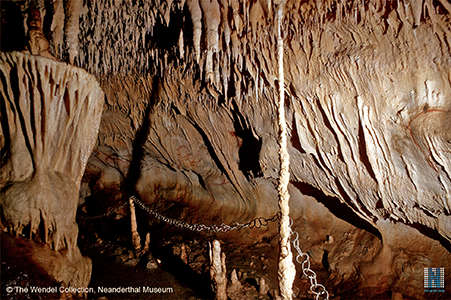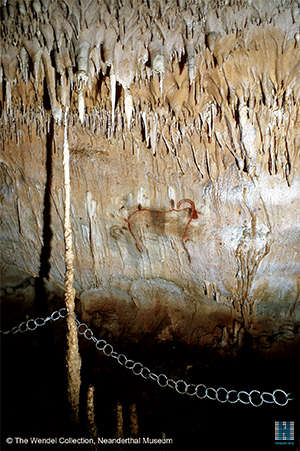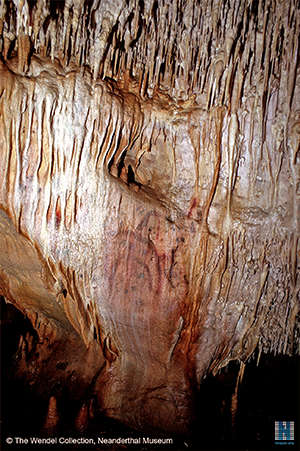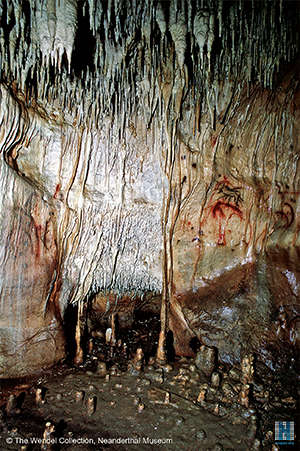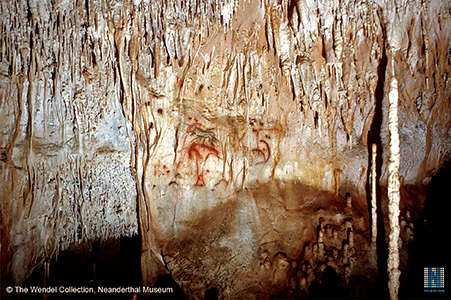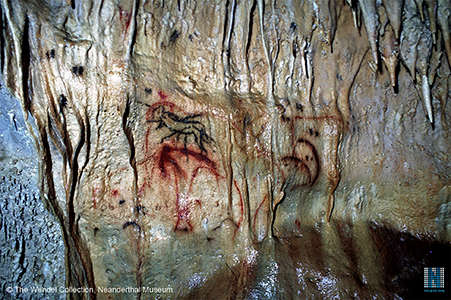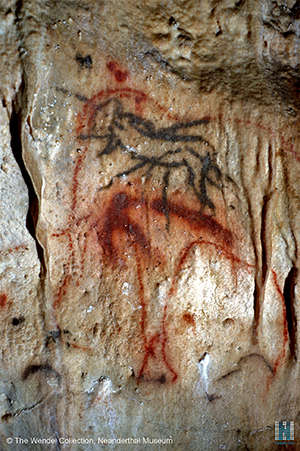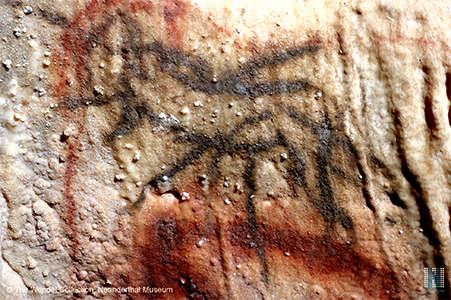Back to Don's Maps
Back to Maps Page
 Back to Archaeological Sites
Back to Archaeological Sites  Back to the review of hominins
Back to the review of hominins
Cougnac Caves - Grottes de Cougnac
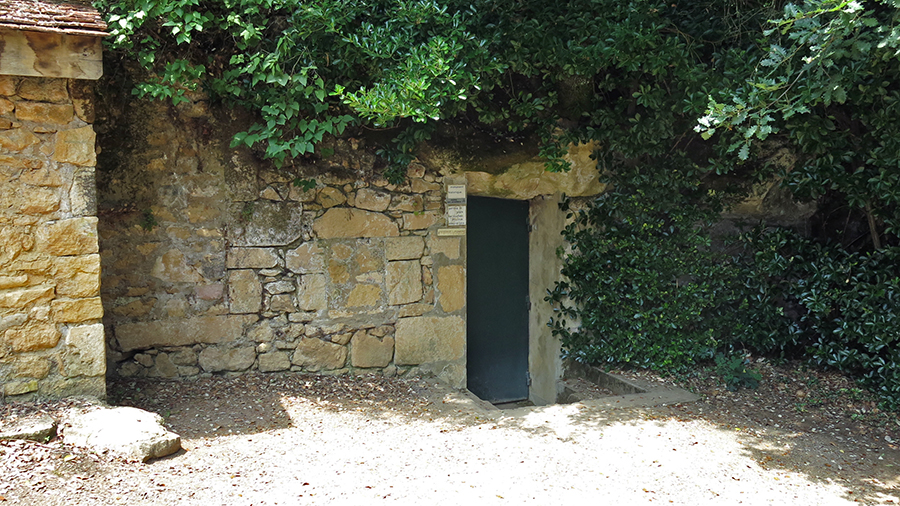
Main exterior entry to the decorated Grotte de Cougnac
Photo: Don Hitchcock 2014
The Grottes de Cougnac caves are near Gourdon, Lot. The site consists of two caves separated by 200 metres. The first contains many concretions, some very fine, called soda straws. The second is a decorated cave from the Paleolithic. Les Grottes de Cougnac were discovered in 1952 by Lucien Gouloumès Rene Borne, Jean Mazet, Roger, Maurice Alphonse Sauvant Boudet. The cave has many prehistoric paintings dated to the upper Paleolithic. Depictions include deer, Megaloceros, the ibex, and mammoths as well as various schematic human figures, interpreted as wounded men, virtually identical to similar figures at Pech Merle. Direct dating has been carried out by the carbon 14 method on samples of carbon used for some drawings. They showed that the paintings corresponded to at least two clearly distinct phases: one around 25 000 BP (Gravettian) corresponding to the animal figures, the other during the Magdalenian, about 14 000 years before the present.
Initially, visitors are taken through the first cave of the two in the complex, one which has many concretions, including the stalactites and stalagmites shown in these images, but which is otherwise undecorated, and was never used by humans.
They then walk the short distance to the decorated cave for a tour there.
Photo: Don Hitchock 2014
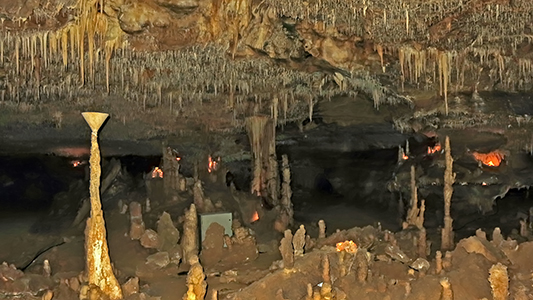
The cone on the stalagmite to the left is a light to illuminate the ceiling.
Photo: Don Hitchock 2014
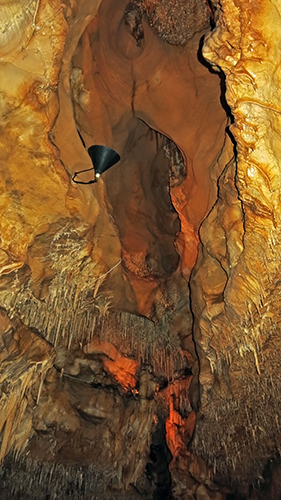
In places like this, water percolating down from the ground above has dissolved much of the limestone, leaving large 'holes' in the overall height of the ceiling.
Eventually it is likely that this will become a sinkhole.
Photo: Don Hitchock 2014

Soda straws develop when a slowly forming drop of water deposits lose carbon dioxide to the air of the cave, depositing calcite on the outside of the drop. This slowly develops into a long, hollow, translucent tube of calcite, of the same diameter as the drops of water travelling down the inside of the tube. The drops at the end of the straw give up carbon dioxide in turn, and the straw can develop into a considerable length.
They occasionally, as here, occur in very large numbers, creating a delicate and beautiful formation.
Photo: Don Hitchock 2014
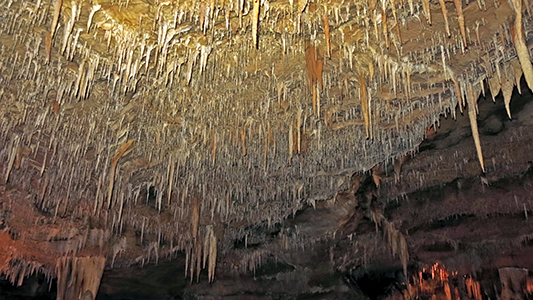
Eventually, perhaps during a dry time when the drop is not replaced quickly enough, the tube will become blocked by calcite.
The calcite rich water then travels along the outside of the straw, depositing calcite as it goes, and thickening the straw until it becomes a stalactite, as can be seen here in some instances.
Photo: Don Hitchock 2014
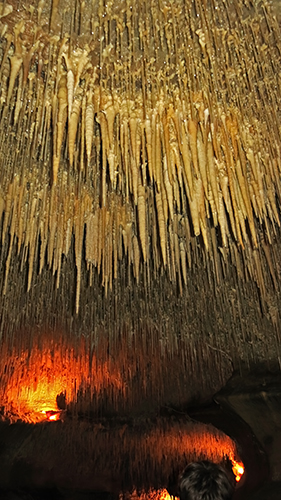
The process of a soda straw changing into a stalactite is well under way here.
As can be seen in this image, the lighting of the cave is very effective.
Photo: Don Hitchock 2014
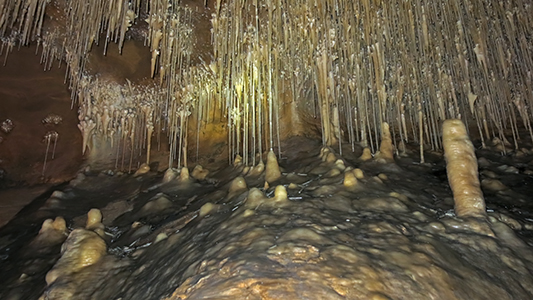
This image fortuitously illustrates a number of features in limestone caves such as this. Firstly, drops of water that fall from the ceiling or from soda straws give up their carbon dioxide on the floor of the cave, creating a film of calcite known as flowstone. This can also form on the walls of a cave.
Secondly, we can see that some soda straws have reached the floor of the cave, and have built up a thicker mound of calcite there, called a stalagmite. Stalagmites can also form simply from drops falling from the ceiling, as can be seen in the example at the right foreground.
Thirdly, we can see that several exit points of water from the ceiling appear to have combined their calcite deposits into one shape, making a star like structure on the ceiling, or close to it, which morphs into a smooth stalactite.
Photo: Don Hitchock 2014
After leaving the first cave, it is a pleasant walk through a wooded area to the decorated cave.
Photo: Don Hitchock 2014
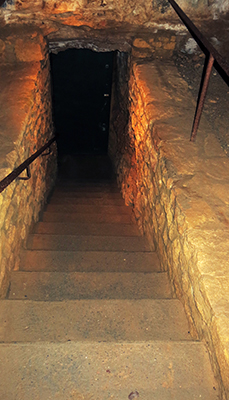
Once through the main outside door, there is a second entry to the decorated cave down a steep flight of stairs.
Photo: Don Hitchock 2014
The Grottes de Cougnac contains images from the paleolithic. There were 60 images of animals, 50 outlines of hands, and 3 images of humans found.
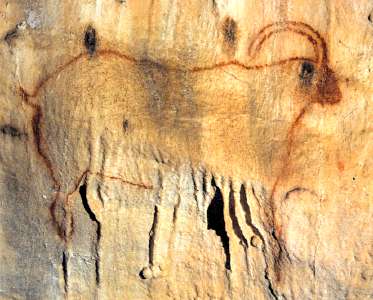
Grand bouquetin rouge, Grotte de Cougnac, Lot.
Large red ibex from the Cougnac Cave, in the Lot region.
Note the way that the placement of the ibex has been chosen so that the flowstone on the wall suggests long hair hanging from the belly of the animal.
Photo from: Agenda de la Préhistoire 2002 - 2003, a superb diary with excellent illustrations sent to me by Anya. My thanks as always.
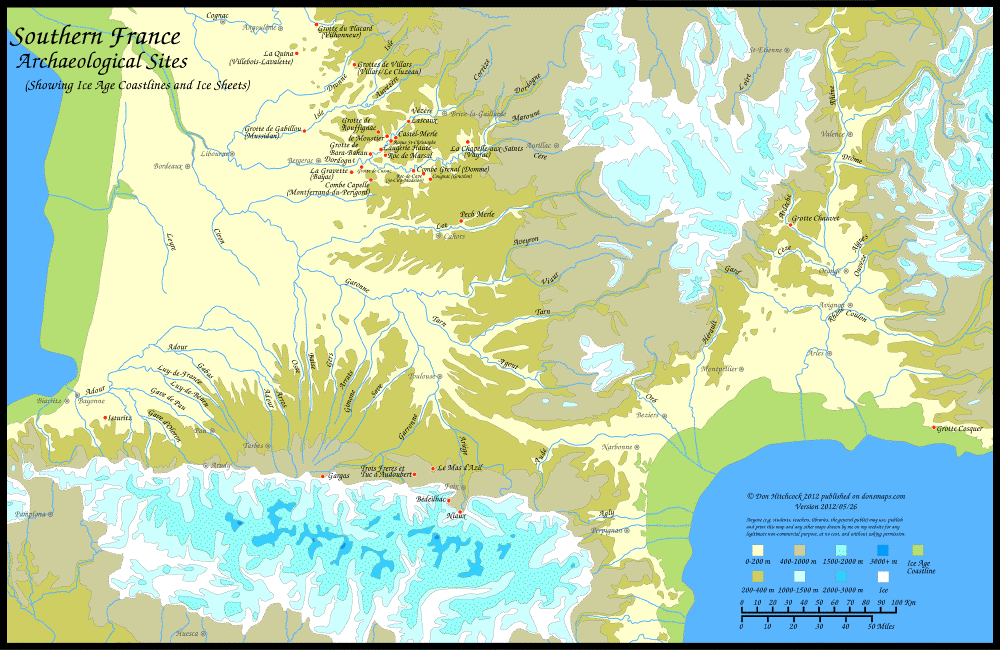
Note - Use this pdf file if you wish to print this map on a single sheet of paper.
Photo: Don Hitchcock version 2012/05/26
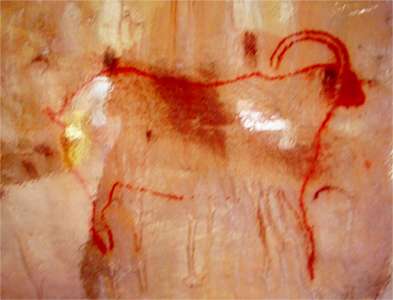
Ibex
Photo: GM, Panoramio
Date: 2007/07/29 18:16:55 no flash
From Bahn (2007):
Local red ochre was used to paint the figures. Cougnac was the site for the first direct radiocarbon date for Ice Age cave art. In the late 1980s, Michel Lorblanchet had a sample taken from a black charcoal dot located near the last mammoths on the right hand end of the frieze. It yielded a date of about 14 000 BP; samples of paint from one male megaloceros later produced dates of 23 610 and 22 750 BP, while the female megaloceros yielded two very different dates of 25 120 and 19 500 BP. This may indicate that the cave's art, originally produced 23 - 25 000 years ago, was touched up a few millennia later, while the dot indicates that some Magdalenians entered the cave much later and, while respecting the original art, marked the walls with their fingers quite extensively.
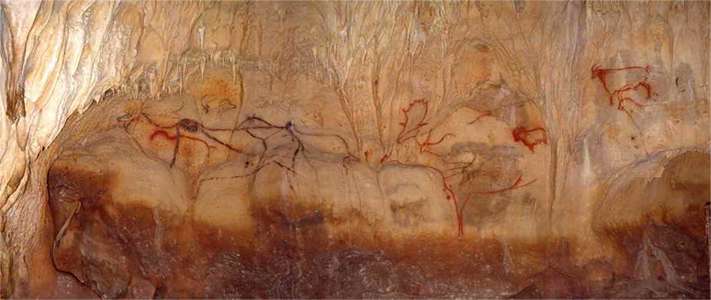
Grotte de Cougnac, Lot.
Large frieze of Megaloceros with their characteristic dark hump which contains muscles and ligaments to support their head and large antlers, ibex, and an enigmatic drawing of what appears to be the trunk and legs of a man with spears in the back and rump.
Photo: http://www.grottesdecougnac.com/Sitefr/index.htm
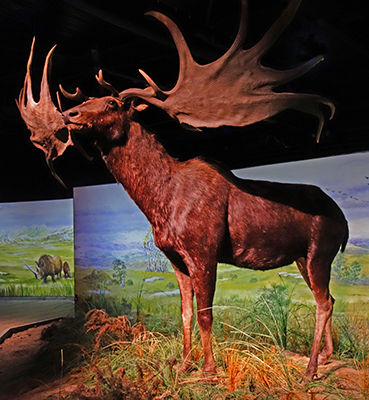
Megaloceros were a good source of meat, skins and bones.
Photo: Ralph Frenken 2019
Source: Le Parc de la Préhistoire de Tarascon-sur-Ariège

Frieze, Cougnac
Photo: Leroi-Gourhan (1984)
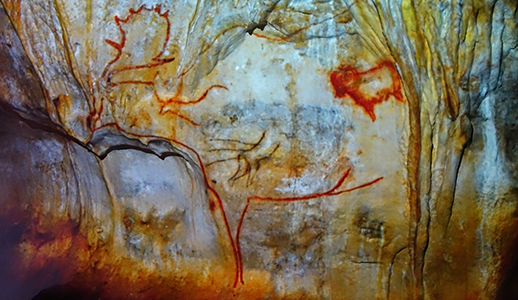
Frieze.
Photo: Ralph Frenken 2019
Source: Facsimile, Le Parc de la Préhistoire de Tarascon-sur-Ariège
In 1990 and 1992, some samples were taken by Michel Lorblanchet and Mrs Hélène Valladas from black paintings in the Cougnac cave (Lot region), especially from the megaloceros panel and some dots made by fingers.
In 1992, Mme Hélène Valladas and her team (CNRS laboratory in Gif sur Yvette, close to Paris) obtained radiocarbon dates with these samples :
Megaloceros panel : about 23 000 and 25 000 years before present.
Dots : about 14 000 years before present. Lorblanchet (1993)
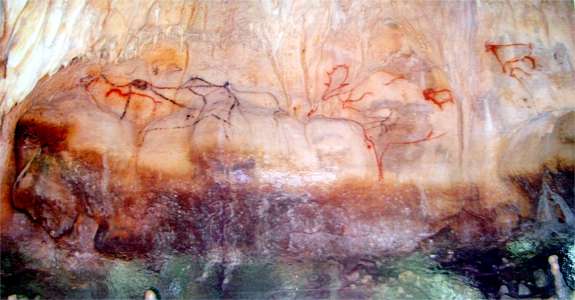
Frieze
Photo: GM, Panoramio
Date: 2007/07/29 18:17:03 no flash
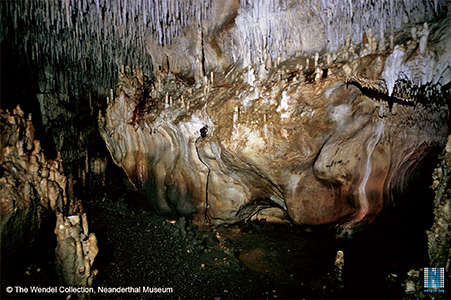
Signs on a protuberance on a wall.
Photo: Heinrich Wendel (© The Wendel Collection, Neanderthal Museum)
Close up of the signs, and the signs in context.
The exact right angle sign shown here is most unusual in cave art.
Photo: Heinrich Wendel (© The Wendel Collection, Neanderthal Museum)
Typical 'Placard' signs (named after those in Grotte du Placard) may be seen on the lower parts of the wall. Similar signs are known from Pech Merle, less than fifty kilometres away, and from Cosquer, many hundreds of kilometres away.
Photo: Heinrich Wendel (© The Wendel Collection, Neanderthal Museum)
This is a drawing of the signs from this panel. Not all are visible in the photographs. They are in a gallery deep within the cave.
Placard type signs are known from not just Grotte de Placard, but also from Grotte de Cougnac, Pech Merle and Cosquer. These signs are from Grotte de Cougnac.
The signs are not associated with other figures.
The wounded man theme is rare in Paleolithic art, but occurs at both Cougnac and Pech-Merle, as well as Lascaux.
In both Pech Merle and Cougnac, the Placard signs are localised to a single panel, in areas deep within the cave, away from areas which are easily accessible. Neither Pech Merle nor Cougnac were inhabited, they were strictly for ceremonial purposes.
Photo: http://ma.prehistoire.free.fr/cougnac_plac.htm

Close up of some of the signs.
Photo: Heinrich Wendel (© The Wendel Collection, Neanderthal Museum)
The six black dots here appear to have been added at a later time to what may be a very faded tectiform in ochre.
Photo: Heinrich Wendel (© The Wendel Collection, Neanderthal Museum)
Signs further to the right of the six black dots, on the next panel. There is an indistinct line drawing on the right of the left hand image that may be of the head and forequarters of a horse.
The closeup on the right reveals another sign hidden by shadow in the left hand image. Both are of open ended oval shapes, the one on the right having two dots within it.
Photo: Heinrich Wendel (© The Wendel Collection, Neanderthal Museum)
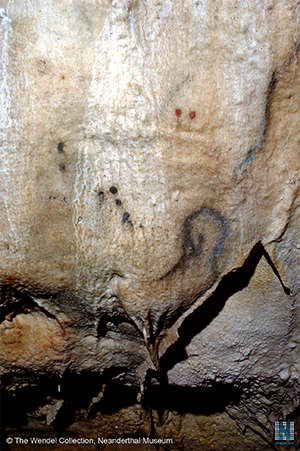
Closeup of the signs on the right hand side of the left hand image above.
Here are two groups of two and four black dots, a group of two red dots, and a similar open ended oval sign to the others on its left.
Photo: Heinrich Wendel (© The Wendel Collection, Neanderthal Museum)
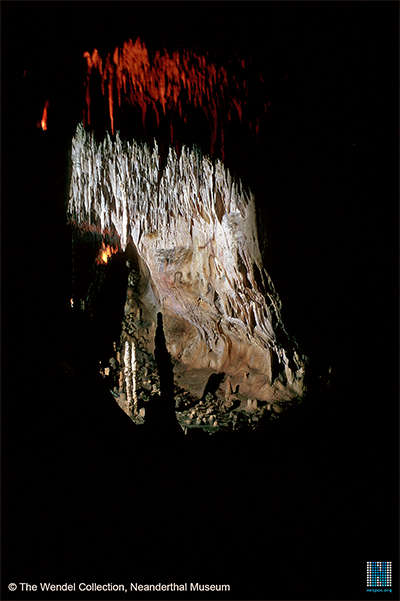
This is a dramatic image of the signs in context.
Here we can see clearly another version of the drawing of the head and shoulders of a horse.
Photo: Heinrich Wendel (© The Wendel Collection, Neanderthal Museum)
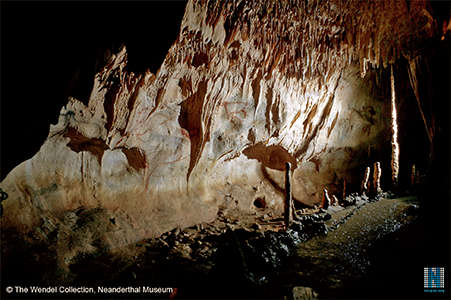
The main panel of paintings at Cougnac.
Photo: Heinrich Wendel (© The Wendel Collection, Neanderthal Museum)
On this important panel we can see at left a Megaloceros with characteristic black hump on the shoulders which was necessary for the muscles and tendons to hold up the immense weight of the head and horns.
Overlapping that is another in outline, again with a black hump, then to its right is the head and forequarters of a Megaloceros in red ochre.
On the red outlined Megaloceros is the famous wounded man, with three spears in his back, then to the right is a well painted Ibex, then a Tahr and another less well drawn Ibex.
Photo: Heinrich Wendel (© The Wendel Collection, Neanderthal Museum)

This image shows the first two Megaloceros on the left, with the dorsal outline of a mammoth and the top of its head, completed in red ochre.
Photo: Heinrich Wendel (© The Wendel Collection, Neanderthal Museum)
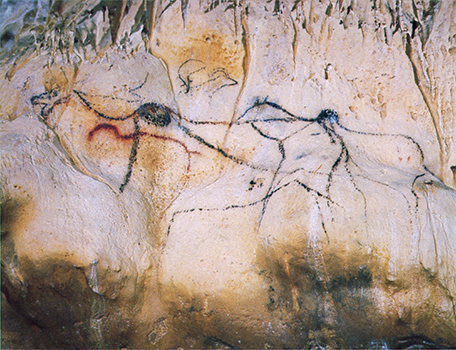
Frieze, Cougnac
Photo: Leroi-Gourhan (1984)
On this red Megaloceros is outlined the 'wounded man' with three spears in his back, a deer on the neck of the Megaloceros, and a well proportioned and painted Ibex.
Photo: Heinrich Wendel (© The Wendel Collection, Neanderthal Museum)
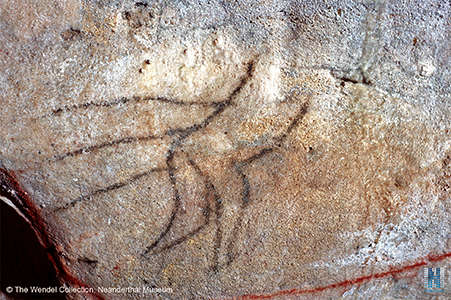
The 'wounded man' has two spears in his back, and one in his upper thigh or buttock. No blood has been indicated, it is a simple outline in black.
Photo: Heinrich Wendel (© The Wendel Collection, Neanderthal Museum)
Close up (left) of the left hand Ibex, and (right) of the Tahr and the right hand Ibex.
It seems to me that the left Ibex and the Tahr were done by the same talented artist, and the third Ibex by an amateur or a child.
Photo: Heinrich Wendel (© The Wendel Collection, Neanderthal Museum)
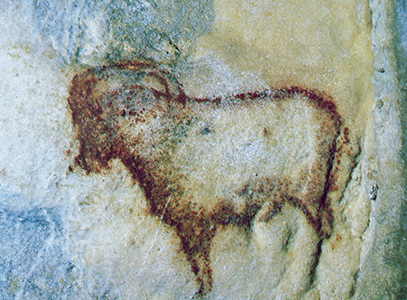
Ibex, Cougnac
Photo: Leroi-Gourhan (1984)
Looking back at the previous panel, and the next panel which contains an Ibex outlined in red ochre.
Note the way that the chain has been attached to stalagmites!
Photo: Heinrich Wendel (© The Wendel Collection, Neanderthal Museum)
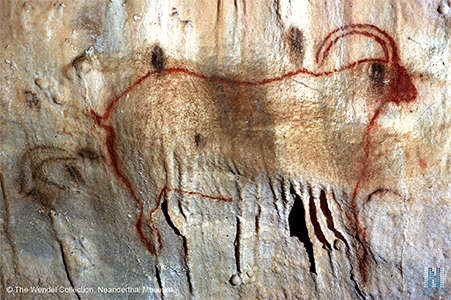
Closeup of the Ibex.
Photo: Heinrich Wendel (© The Wendel Collection, Neanderthal Museum)
(left) Some enigmatic paintings, now covered in calcite. Although this clouds the paintings to some extent, it also has a wetting effect which enhances the colour, and also protects the paintings from damage.
(right) The wall continues past some flowstone, with another wounded man on the next panel.
Photo: Heinrich Wendel (© The Wendel Collection, Neanderthal Museum)
In this image we can see the outline of a red ochre mammoth completed in a thick red line, with another 'wounded man' in black, with many spears stuck in his naked body overlapping it, two large black horns of an ibex, a diagram of a mammoth with straight back, his head and trunk, then the black outline of the skull and the beginning of the back of a mammoth, and frequent pairs of fingerprints in black and red.
These paintings have been drawn on a thick coating of calcite on the walls, some of which were covered subsequently with a thin veil of calcite. Depending on the humidity of the underground environment and the water status of the walls, the legibility of the paintings varies. In the autumn in general painted strokes are very visible; by contrast in winter (the period in which this photograph was taken), the features become less distinct. The attenuation of the colours is probably due to a temporary clouding of the veil of concretion deposited on the paintings. The phenomenon has a periodic nature, and closely follows climate fluctuations.
Photo: Heinrich Wendel (© The Wendel Collection, Neanderthal Museum)
Text: adapted and translated from: http://www.culture.gouv.fr/culture/conservation/fr/grottes/Pageshtm/3191.htm
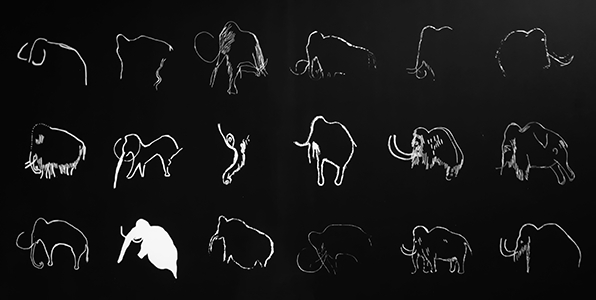
This shows the broad range from a large number of caves of the outlines of mammoths, often a preferred method of representation of this animal.
Photo: Ralph Frenken 2019
Source: Display, Le Parc de la Préhistoire de Tarascon-sur-Ariège
Closeup of the 'wounded man'.
Photo: Heinrich Wendel (© The Wendel Collection, Neanderthal Museum)
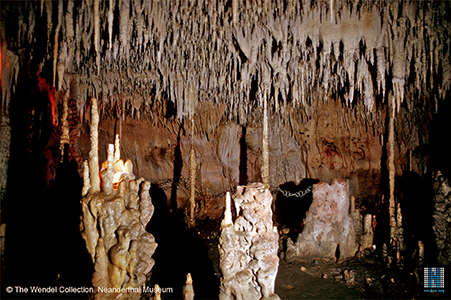
This is a good view of the right hand part of the main panel, with an Ibex and the Mammoth and wounded man visible.
Photo: Heinrich Wendel (© The Wendel Collection, Neanderthal Museum)
Une représentation de Tahr (Hemitragus) à Cougnac?
A representation of a Tahr (Hemitragus) at Cougnac?
Visiting Cougnac II in the spring of 1953 we were struck by a drawing which seemed to represent a Tahr, as there are still in the Himalayas. Méroc et Mazet (1953) describe in Cougnac "four big cervids, a deer, five elephants, three human figures and seven ibex, a pair of black horns, two animals drawn in black. The legs of one ibex disappeared in flowstone draperies that simulate a long fleece along its belly. A second is characterized by its small straight tail, whose boldness is exaggerated by three prickly hairs at its end."
This last animal is the one which may be a Tahr. Of the three species, the best known, Hemitragus jemlaïcus occurs in the mountains of the Himalyas. It is a beautiful animal which can sometimes be seen in zoos. Its height is 90 cm, and can reach a weight of 100 kg. While the head and legs have short dark hair, the neck and front are covered with lighter fleece which in winter can reach or exceed 30 cm in length. The hair on the head is a greyish brown.

Tahr and Ibex drawn on the walls of Cougnac
Photo: http://www.mrugala.net/Histoire/Prehistoire/France,_Perigord_&_Quercy,_Grottes/
Original Source: GEO N°281 de juillet 2002
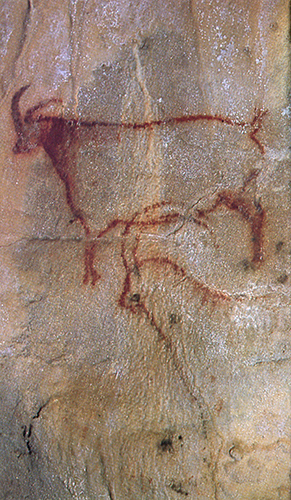
Tahr, left, and Ibex, right.
Photo: Leroi-Gourhan (1984)
At Cougnac, the animal that we take for a Tahr is found, serendipitously, on the same panel as a true ibex, so it is possible to compare them and also to photograph them on the same film. We see at first glance that the upper animal is clearly distinguishable from the lower. The horns of the first are shorter than the second, in which they form almost a semicircle. Doubtless it could be objected that the first animal is simply a female ibex. The horns alone would dismiss this identification. Indeed in the Tahr the horns are short and the front edge is sharp. The length, measured in a large male following this edge does not exceed 25 cm.
But there are still other distinctive characters: our Tahr's head is thinner and more elongated than the Ibex. The line of the back is nearly straight and is not interrupted by the bent neck.
Finally, the Tahr head and legs are black, unlike the Ibex of the cave. In weighing the pros and cons it seems that the probability that it is a Tahr is much greater than it being a female ibex.
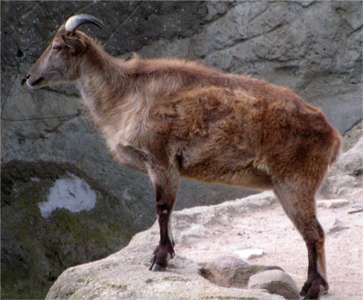
Tahr
Photo: 22.08.2004 in Hagenbecks Tierpark, Hamburg by Michail Jungierek
License: This file is licensed under the Creative Commons Attribution-Share Alike 3.0 Unported license
If the Tahr existed in France during the Pleistocene, it might be said that we should already have found its bones in the deposits. To which we reply that these bones may have been confused with those of other goats, including the ibex.
But we have more relevant data: the skeletal remains of Tahr were actually found a long time ago, not far from Cougnac. Indeed, remnants of this kind had already been exhumed at the end of last century by Bonal in a small cave of the Céou Valley, near Sarlat. They were described by Harle and Stehlin in a communication to the Geological Society of France in 1913. There was, in particular, a skull fragment with the root of the horns, teeth, etc. These pieces are in the Basel museum, as well as in Villeneuve-sur-Lot. According to Cartailhac they were accompanied by the appearance of Mousterian flint.
Charles (1952) reports having found Tahr in the two caves: the Vallon des Cedres, massif de la Sainte-Baume (Var) and at l'Adaouste (B.-du-Rh.) each time with a fauna adapted to cold and wet conditions. M. Charles compared the teeth of the Tahr with those of a Hemitragus jemlaïcus at the Muséum de Marseilles and specifies that it is impossible to distinguish the fossil teeth from those of extant species in the Himalayas.
References
- Bahn P., 2007: Cave Art: A Guide to the Decorated Ice Age Caves of Europe, Frances Lincoln Ltd
- Charles R., 1952: Faune pleistocene du Vallon des Cèdres. Bull. Soc. préhist. fr., p. 294.
- Charles R., 1952: Faune des couches paléolithiques de la grotte de l'Adaouste. Bull. Soc. préhist. fr., p. 487.
- Jaubert, J., 2008: L'art pariétal gravettien en France : éléments pour un bilan chronologique », Paléo, 20 | 2008, 439-474.
- Koby F.-Ed, 1956: Une représentation de Tahr (Hemitragus) à Cougnac ?, Bulletin de la Société préhistorique française 1956, tome 53, N. 1-2. pp. 103-107.
- Leroi-Gourhan A., 1984: L'Art des cavernes : Atlas des grottes ornées paléolithiques françaises, Relié – 1 décembre 1984
- Lorblanchet M., 1993: Payrignac, grotte de Cougnac, datations de pigments pariétaux au radiocarbone, Bilan scientifique 1992 (SRA DRAC Midi-Pyrénées), p.99-100.
- Lorblanchet M., 1995: Les grottes ornées de la Préhistoire. Nouveaux regards Paris : Éd. errance, 288 p.
- Lorblanchet M., Labeau M., Vernet J., Fitte P., Valladas H., Cachier H., Arnold M., 1990: Étude des pigments de grottes ornées paléolithiques du Quercy., Bull. de la Soc. des Études du Lot 2, p. 93-143.
- Méroc et Mazet, 1953: Les peintures de la grotte de Cougnac (Lot). L'Anthropologie, p. 490

